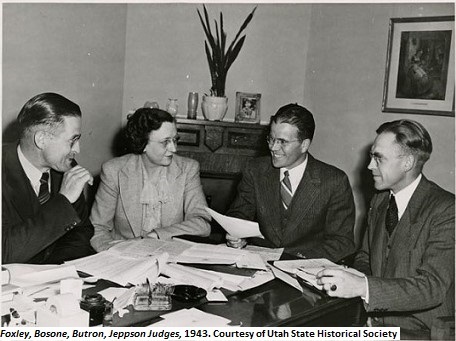Dublin Core
Title
Description
The early political history of Utah women began with the 1870 law that gave women the right to vote.
With all of the attention on Hillary Clinton’s historic campaign for President, it might be interesting to take a look at the history of women’s involvement in Utah politics. The right to vote came early for Utah’s women. In 1870, the territorial legislature passed a law giving Utah’s women the vote, though not the right to hold office, making Utah only the second territory in the nation to enfranchise women. Ironically both Mormon leaders and anti-polygamy activists saw the move as a step in the right direction—the Mormons because they believed it proved that women in polygamous marriages were not the slavish, oppressed class many non-Mormons imagined them to be, and the anti-polygamy advocates because they thought Mormon women would actually vote to kill polygamy in the territory if given the opportunity. Utah women continued to vote in elections for 17 years until Congress revoked the right to vote for Utah women as part of its own anti-polygamy campaign.
By 1895, with Utah’s elevation to statehood a foregone conclusion, the vote was returned to women. The next year, Martha Hughes Cannon, a medical doctor with a degree from the University of Michigan, became Utah’s first female state senator. In the years that followed Cannon’s election, other women were voted into the state legislature. Women were also elected to local government positions. In 1912, for instance, women were given control of the town council and mayor’s office in Kanab, a farming town on Utah’s southern border. According to various source, this may have been the first time in American history that a town council had been entirely composed of women.
In the 1940s, Utahns took another step toward full political integration for women when they elected Reva Beck Bosone to Congress in 1948. Karen Shepard and Enid Green Waldholtz both followed in the 1990s.
Creator
Source
Image: Foxley, Bosone, Butron, Jeppson City Judges, 1943. Photograph of Reva Beck Bosone working with three other city judges in Salt Lake City. Courtesy of Utah State Historical Society.
_______________
See the February 1995 and April 1995 collections of the History Blazer, a joint project of the Utah State Historical Society and the Utah State Centennial Commission. The History Blazer can be found on the Utah History Suite CD available from the Utah State Historical Society. See also Linda Sillitoe, A History of Salt Lake County (Salt Lake City: Utah State Historical Society and Salt Lake County Commission, 1996), 119; Jean Bickmore White, “Gentle Persuaders: Utah’s First Woman Legislators,” Utah Historical Quarterly 28 (Winter 1970): 31-49; Beverly Beeton, “Woman Suffrage in Territorial Utah,” Utah Historical Quarterly 46 (Spring 1978): 100-120; and Lola Van Wagenen, “In Their Own Behalf: The Politicization of Mormon Women and the 1870 Franchise,” in John S. McCormick and John R. Sillito, ed., A World We Thought We Knew: Readings in Utah History (Salt Lake City: University of Utah Press, 1995).

